PART ONE: CHRISTIAN KARMA YOGA
PART TWO: KARMA YOGA FROM INDIA
PART THREE: KARMA YOGA DESCRIBED
PART FOUR: BUT DOES KARMA EXIST?
PART FIVE: CREATIVE KARMA YOGA
PART SIX: HUMAN LOVE KARMA YOGA
CHRISTIAN KARMA YOGA:
THE PATH OF
SELFLESS SERVICE
Christian Yoga is a
means of following Jesus Christ and using disciplines of yoga to assist you. Christian
Karma Yoga is the yoga of selfless
action. Of course, Christianity has had a long history of advocating and
manifesting service as a Christian ideal. Service is the horizontal approach to
the divine through expressing love to others in contrast to the vertical
approach to the divine through inward seeking of God. Seekers who make progress
going within during meditation and contemplation as a vertical experience are
often inspired to find balance in their lives through selfless outer service to
others. The West has been focused very much on material progress and in turn
produced a society that has valued social service, especially in a material
sense, to a higher degree than in the East. The Christian expression of social
service has been understood as an expression of Christian love, as exemplified
by the life and teachings of Jesus.
However, Christian
Yoga selfless action is more than simply social service. Like all the yoga
expressions Christian Karma Yoga involves a turning inward, which is often
missing from social service. Other forms of yoga involve changing the focus
from an initial external orientation to an internal orientation. But Christian Karma
Yoga involves the reverse direction—having an inner dedication initially to the
divine and then going outwardly to express the divine through actions. This
inner dedication separates Christian Karma Yoga from social work. It is not
enough to just make a dedication inwardly. You must carry your divine alertness
with you in the actions as they are being performed.
One approach to using
karma beneficially is to do good deeds to acquire good karma, producing good results in your life. This approach also
includes the avoidance of doing bad deeds that would acquire bad karma, bringing bad results. The
photograph above is a picture of Cathedral Rock at Red Rock Crossing in Sedona,
Arizona. The beautiful image of Cathedral Rock is perfectly reflected in the
water below. The reflection in this photograph has been displayed here as a
symbolic representation of the reflection that karma provides for you. The
positive experiences in your life are reflections of your positive actions,
good karma. The negative experiences in your life are reflections of your
negative actions, bad karma. These reflections are feedback that can show you
how to take responsibility for all your actions based on the results they
produce.
A loftier approach to
using karma beneficially is to dedicate actions to God in the practice of
Christian Karma Yoga. Through this dedication of actions to God, you free
yourself from any karmic results—whether good or bad. This kind of wholehearted
devotion to God offers freedom from all karma. According to Eastern philosophy,
this dedication of all actions to God ultimately leads to freedom from the
karmic wheel of death and rebirth that occurs in reincarnation. This freedom is
the goal of all yoga paths because it means an awakening to perfect oneness
with God. The belief in reincarnation is controversial for Christians, yet this
belief is not absolutely necessary to practice Christian Karma Yoga. You can
believe in reincarnation if you find it is helpful for your spiritual growth,
or you can set aside the belief in reincarnation if that belief is not helpful
for you. However, the vast majority of all seekers are united in the common
goal of seeking divine liberation, although there are many different ideas
about what liberation is and how liberation can be achieved. Christian Yoga is
just one means of attaining liberation—divine union—among many other ways.
In Christian Karma
Yoga, every action is dedicated to the divine and becomes worship manifested in
action. This sanctifies everyday life, making even the most mundane actions
become worship. Worship is giving. The emphasis in Christian Karma Yoga is on
giving to God without thought of personal reward. The aim is to give the fruits
of your work—the fruits of every actions—to God or Jesus. A limited idea of
Christian Karma Yoga is to offer only some specific actions to God. A more
complete application of this path is to dedicate every activity to God as an
overall expression of giving your entire self to God. Thus Christian Karma Yoga
affords the opportunity to perceive your whole life as a divine expression. The
idea is to encourage a sense of prayerfulness throughout the whole day,
even in the most mundane activities of life. The section below discusses the
origin of Christian Karma Yoga in the practice of Karma Yoga that comes from
India.
KARMA YOGA FROM INDIA:
THE PATH OF
SELFLESS ACTION
In classical Hindu
philosophy Karma Yoga is the path of selfless action as a means of spiritual
growth. This path is for the person who leans toward an active life in the
world, but since everyone is active to a certain degree, everyone can benefit
by internalizing and utilizing the practice of Karma Yoga.
The beauty of Karma Yoga is that it takes ordinary actions and everyday mundane work and elevates these to divine expressions. Karma Yoga can be practiced by simply allowing whatever form of work that you do to be done as a service to God with no thought of looking to the fruits of your labor. Karma Yoga is sometimes called the yoga of “work.” A better way of describing Karma Yoga is to say it is the yoga of “dedicated action.” In fact, the verb “kri,” meaning to do, is the root word from which the word karma is derived. So any action can be an expression of Karma Yoga, if that action is performed with dedication to the divine. By dedicating the action to God, the action becomes selfless and a divine expression. One of the best examples of Karma Yoga is Mahatma Gandhi, who certainly lived a holy life of dedicated action. Even when he was shot by an assassin's bullet, he verbally called out a Divine Name of God, dedicating even his last breath to the divine Source.
MAHATMA GANDHI
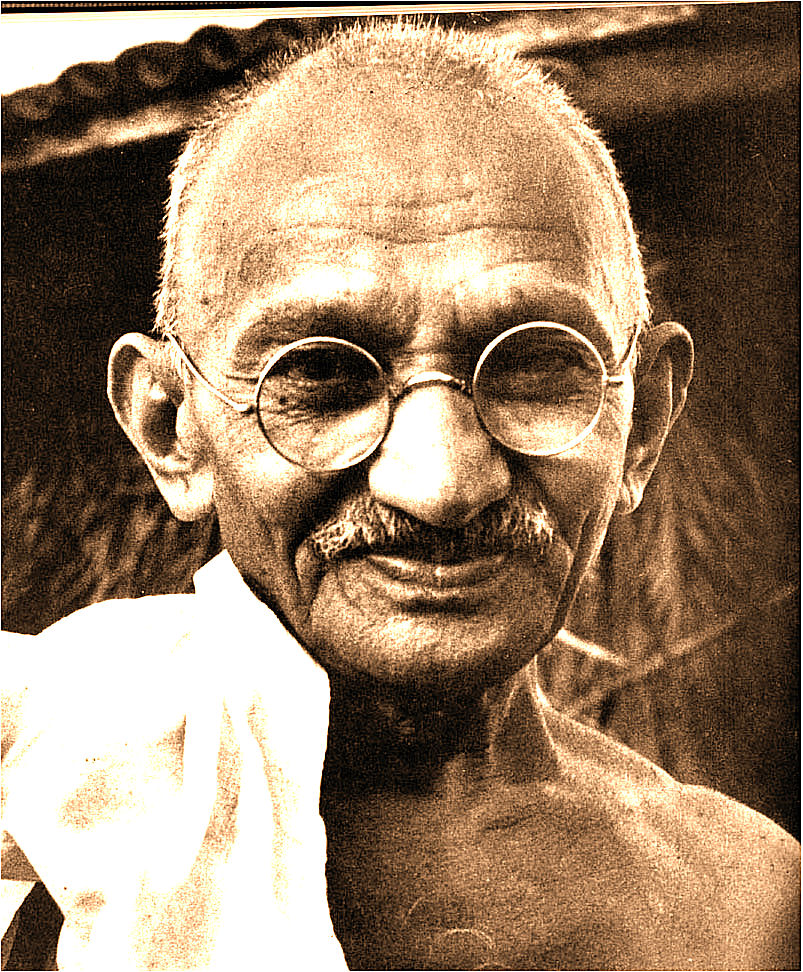
The expression of Karma
Yoga can be impersonal or personal in nature, but in either case there is a
twofold activity of turning within and then turning outward. When Karma Yoga is
expressed in an impersonal manner, the individual turns inward to make contact
with the impersonal Brahman. This turning inward may be meditation, which is
part of each path of yoga, or it may be a momentary dedication of oneself to
the infinite Reality. This turning inward to the infinite is then followed by a
turning outward to the finite in the form of action or work. In this case work
is done for its own sake. It is the Atman, the indwelling Brahman, in the karma
yogi that is doing the work simply because it is a good thing to do. When Karma
Yoga is expressed in a personal manner, the individual turns inward by choice
to make contact with a personal aspect of God. For example, if the chosen
personal form of God is Krishna, the karma yogi inwardly offers the results of
his actions or work to Krishna. This is a form of devotional worship. This
worship is independent from the value of the work from a worldly perspective
that makes distinctions between lowly work and lofty work. Every offering of
work is equally important as a gift on the altar of worship.
This inward personal
dedication may be made through meditation, through prayer, or through a ritual
action of worship before an altar. After the inward dedication, the karma yogi
can then perform the outward action or work with no personal motivation. Since
the fruits of one’s actions are given away in worship, the karma yogi can be
free from any concern about the results.
Karma Yoga transforms
bondage into freedom. Normally there is a link between action and desire. In
Vedanta the individual is in a state of ignorance of his own divine nature due
to maya, the illusions of this
world. Because of ignorance the individual has desires for things that are not
divine and therefore not in accord with his true nature. Desires motivated by
the ego lead to action, which is karma. Karma is best understood as both action
and the results of action. Desires of the ego produce actions that have automatic
results—meaning karmic results.
Karma Yoga is
practiced to remove the ego desires so the link between desires and action is
broken. When the desire is removed from the action, there is no karmic result.
Instead of being bond by karma, the karma yogi is freed to perform actions
without incurring any automatic results of a karmic nature. If work is done in
an impersonal manner for its own sake without any personal ego investment,
there is no karma. Also if work is done in a personal manner in which the
worker specifically gives the fruits of his work to his personal form of God,
there is no karma. Karma is seen as the bondage that keeps the soul bound to
this world, so breaking this bondage leads to liberation—to awakening the
divine kingdom within.
KARMA YOGA DESCRIBED
Donald James Giacobbe is the author of Memory Walk in the Light: My
Christian Yoga Life as “A Course in Miracles.” In excerpts below from his
autobiography, he describes his practice of Christian Karma Yoga.
Autobiography
of a Yogi also talked about karma, the idea
of cause and effect applied to the mind and to our deeds.
Karma
is the justification for reincarnation, in which souls come back to meet their
karma. This explained to me that individuals born with handicaps, such as
mental retardation or physical limitations, are meeting karma from a past life.
I liked the idea that reincarnation contradicted the concept of living one’s
life with Heaven or hell as the only two final destinations. Instead of being
banished to hell by God, we would have endless opportunities to wake up from
the illusion of this world. In the Catholic religion the place between Heaven
and hell, called purgatory, was where souls could pay for their sins with
temporary suffering before being allowed to enter Heaven. I came to believe
that there is no hell and that this world itself is like a purgatory where we
can face our karma through reincarnation until we eventually make our way to Heaven.
The
bounce-back of karma was not merely a theoretical idea in my mind. I had
previously experienced situations in which I could see my karma coming back to
me, which I had previously set in motion by my desires, thoughts, and deeds.
The first time I saw this clearly was when I was playing touch football with
friends and I was angry at one player on the opposing team. As I approached
this opponent on the kickoff, I decided to block him by sticking my head into
his stomach. In particular, I remember I had the desire to hurt him, which was
unusual for me. At impact my cheekbone hit against his hipbone, and yet he kept
on running as though I hadn’t even touched him. I, on the other hand, had a
broken cheekbone and needed surgery to have it repaired. I attributed this not
just to a meaningless accident, but to my intention to hurt him bouncing back
to me and hurting me instead.
˜ ˙ ˜
Karma is at times thought of as one
thing, when actually there are three kinds of karma. An analogy from Vedanta
scripture illustrates this: An archer carries on his back a bunch of arrows in
his quiver. He has shot an arrow that is still flying in the air as he quickly
grabs another arrow and is about to shoot it. The bundle of arrows in the
quiver is accumulated karma, which consists of all the karma that has
been acquired in one’s past. Part of this accumulated karma is a person’s
character, which includes his desires, tendencies, talents, and personality. It
is whatever you are holding in your mind from the past. The second kind is
represented by the arrow that is in the air and cannot be stopped. This is the fruit-producing
karma, which cannot be avoided since it is already taking effect and must
be experienced. The third type, the arrow that is being held but has not yet
been shot, is new karma, being manufactured now, that will be the source
of future karmic effects.
I
was interested in what these three karmas meant for me personally. The
fruit-producing karma was my means of feedback for spiritual growth. I could
see that whatever I was experiencing was something that I had caused by my past
desires, thoughts, and actions…. Understanding that all my experiences were
personally deserved became my means of taking responsibility for my growth.
˜ ˙ ˜
Karma
Yoga is the practice of working and living in accordance with the law of karma.
The word “yoga” literally means union, and the ultimate goal of all forms of
yoga is union with God. Consequently, the ultimate goal of Karma Yoga is divine
union. According to yoga philosophy, the soul after death has three possible
destinations. When the physical body dies, the vital forces of the body
transfer to a more refined vehicle called the astral body. The astral
body carries the karmic impressions recorded in the mind in a seed form. Those
who have devoted their lives to God and done good works without selfish motives
are guided by a perfectly awakened soul, who leads seekers to the sphere where
they awaken to their oneness with God, achieving liberation. I could see Jesus
fulfilling this role of being a guide, who helps souls to awaken fully to
divine union.
The
souls of seekers who have done good works, but who mixed these with selfish
desires, can ascend to various astral planes or even to heavenly spheres where
seekers receive the benefits of their good actions. However, when the merits of
their good karma are exhausted, they must return again to earth in a human
incarnation to continue with their spiritual evolution. Souls who have
predominantly bad works with selfish motives can temporarily become ghosts or
even demons in lower realms until it’s time to come back to the earth in human
form to have another opportunity to grow spiritually and eventually wake up to
their oneness with God. In general this philosophy made sense to me because I
remembered that Jesus had said, “In my Father’s house there are many mansions.”(1)
Nevertheless, I gave no credence to the Hindu belief that very evolved souls
could become “gods” in a celestial realm or very unevolved souls could be
reincarnated as animals.
Seekers
who understand that karma affects their spiritual growth and afterlife
destination attempt to increase good karma and decrease bad karma. No actions
are all good or all bad and more important than the actions themselves is the
intention behind each action. No action can be automatically good or bad in
itself. For example, a charitable work may be done for a selfish motive, such
as power, pride, or praise, and lose some of its virtuous quality. A killing of
a criminal who is about to kill a hostage can be a noble act of a policeman who
is performing his duty as a service to others. Consequently, the good and bad
values of karmic experiences are determined by the motive.
Imagine
that a man asked two of his nephews to work in his field, and he offered to pay
each of them $100 for one day of work. At the end of the day one nephew came to
his uncle with his hand out and was given $100. Next the other nephew went to
his uncle and said, “My dear uncle, this work is my gift to you. There is no
need to pay me.” The uncle hugged him, stuffed the money in his pocket, and
said, “My beloved nephew, thank you for your gift. This money is not payment
for your work. It is my gift to you.”
Both
nephews were given $100, but only the nephew who performed his work as a gift
without thought of a return was practicing Karma Yoga with the necessary motive
of selfless service. In this analogy the uncle represents God. Karma Yoga is
the practice of dedicating the fruits of one’s actions to God. According to Karma
Yoga philosophy, to overcome all illusions and awaken to union with God
requires letting go of the desire for both the good and bad fruits of one’s
actions.
In
contrast to the selfless motivation in Karma Yoga, I was faced with the fact
that in my youthful twenties I had lived an almost entirely self-centered life.
My immature work ethic could be summed up by one of Ronald Reagan’s quips:
“Hard work never killed anybody, but why take the chance?” Because of this, I
found the ideal of Karma Yoga to be beyond my capabilities. I decided that it
would be unrealistic and foolhardy to think that I could remove all my personal
desires from my actions. Buddhism also advocates desirelessness as the way to
overcome suffering in life, and I had attempted to manifest desirelessness in
my past experiences but found that it was not helpful for my personal growth,
so I did not want to go in that direction again.
I
decided to focus on developing a less exalted form of Karma Yoga than totally
selfless service, which requires saintly qualities. Just as a person can be a
Christian without being a perfect follower of Christ, a person can be
practicing Karma Yoga to a certain degree by any form of service, such as being
a teacher or social worker, even if some selfish motives are mixed with
unselfish motives. Karma Yoga is sometimes thought of as the yoga of “work.”
However, it is more properly understood to be the yoga of “dedicated action.”
Consequently, any action, no matter how mundane, can be an expression of Karma
Yoga, if that action is performed with a spiritual motivation.
Accepting
responsibility for being the cause of our own karma encourages us to make good
choices that will return good karma to us. Although karma literally means
action or deed, karma is not limited only to setting actions in motion at the
form level and reaping the concrete results of those actions. Karma, as the law
of cause and effect, involves understanding that thoughts also act like a boomerang. Loving thoughts sent out to
others come back as the non-physical mental karma of loving thoughts from
others coming back to us. Unloving thoughts sent to others come back as the
mental karma of unloving thoughts directed toward us. Jesus expressed this idea
of mental karma by saying, “Judge not, and you will not be judged; condemn not,
and you will not be condemned; forgive, and you will be forgiven.”(2) Here
Jesus is recommending a spiritual application of the law of attraction, but He
is not recommending this law as a means of getting what you want at the
material level.
Seeking
an application of the law of karma that would be in accordance with the
teachings of Jesus, I adopted my own variation of Karma Yoga, which I thought
of as Christian Karma Yoga. Since I could not remove all my personal
desires and seeking of the fruits of those desires, I decided to express what I
called enlightened self-interest. I recognized that I had a goal-oriented
personality and possessed the discipline necessary to achieve goals.
Consequently, instead of trying to remove desires, I decided to choose goals
that expressed spiritually oriented desires rather than the more selfish
desires that I had chosen in the past. I still sought to experience the fruits
of my actions, but I felt this was beneficial because I was seeking the fruits
of the Spirit—“love, joy, peace, patience, kindness, goodness, faithfulness,
gentleness, self-control.”(3) Seeking such fruits was not entirely selfless
from the perspective of Karma Yoga, but did express enlightened self-interest
that would lead me in the direction of waking up to my oneness with God.
According
to the philosophy of Karma Yoga the dedication of one’s actions and the fruits
of one’s actions to God was an expression of worship. I didn’t see my form of
Christian Karma Yoga as a form of worship, but rather as an opportunity to ask
for God’s assistance. For me, dedicated action is not just about getting a
spiritual result. It also meant including God in the process of that action by
asking for His help either prior to or in the process of taking some action.
This applied to asking for help in work situations, as well as asking for help
in mundane activities. For example, I would often ask for God’s help when I was
doing something as ordinary as driving my car or writing a letter. Whenever I
started a new project or wanted a new job, I would pray for God’s help.
However, my awareness of Karma Yoga helped me be less attached to whether my desires
were fulfilled or not. I allowed my wanting to be tempered by the example of
Jesus and by ending my prayer with the words, “Lord, not my will, let Thy Will
be done.” In spite of whatever I might think I might need, I felt only God
knows what I really need.
I
felt my Christian Karma Yoga of enlightened self-interest was supported by
Jesus. Instead of advocating the seeking to fulfill material needs, for example
through prosperity consciousness, Jesus taught what was worthy of seeking, by
saying,
And do not seek what you are to eat and
what you are to drink, nor be of anxious mind. For all the nations of the world
seek these things; and your Father knows that you need them. Instead, seek his
kingdom, and these things shall be yours as well.(4)
I
didn’t have many life experiences of practicing service work, so I didn’t
consider myself to be a good example of my Christian Karma Yoga ideal, yet I
wanted to move in that direction. So I took over the full-time duties of an
elementary school art teacher who had left half way through the school year. I
struggled with the demands of the job, especially maintaining class discipline.
I became so focused on being a good disciplinarian that I was losing my
enthusiasm for teaching and did not feel I was effectively serving my students
so I decided to quit. On the day I planned to submit my resignation, a student
came up to me and joyfully asked me to look at a little wooden plaque she held
in her hands. Written on the plaque was a statement acknowledging her recent
Catholic confirmation as a “soldier of Christ.” As I read the words, my eyes
began to well up with tears, and I felt God prompting me to resist the
temptation to quit my job. It did not matter if I struggled with the job and
could not do it perfectly. The important thing was for me to be a soldier of
Christ. I rededicated myself to practicing Christian Karma Yoga for Christ.
Strengthened by this experience, I was able to continue working and finish out
the year.
I prayed for divine guidance on how to become a better Christian Karma Yoga worker and better person. Instead of changing my art teaching job, I changed my attitude and approach. I had been giving every class one project and felt I had to be a hard-line enforcer of discipline. I later loosened up and gave each class a choice of four or five projects, such as painting, block printing, stick sculpture, sketching, and clay projects. Students who wanted to do similar projects sat in small groups and talked quietly in a creative atmosphere. The students no longer needed rigid discipline because they were happier with greater freedom of choice and expression. The new approach required extra planning and coordination on my part. Nevertheless, I was happier too. Without needing to be a disciplinarian, I was free to focus on inspiring my students to explore various forms of self-expression.
The above excerpts
from Donald James Giacobbe’s autobiography express his beliefs when he practiced
Christian Karma Yoga before he became
as student of A Course in Miracles.
Now he practices Miracle Yoga, which
is Christian Yoga combined with the Course. Currently his practice of Miracle
Karma Yoga is based on a different understanding of karma than is expressed
above. Below this alternative understanding of karma in Miracle Karma Yoga is offered
for your consideration.
1. John 14:2
2. Luke 6:37
3. Galatians 5:22-23
4. Luke 12:29-31
BUT DOES KARMA EXIST?
The ideas presented above
about Karma Yoga include the almost universal Eastern belief in the idea of
karma. But that does not mean there is only one way to understand the nature of
karma. It is generally understood that there is a “law of karma” that has been
established from a divine origin. However, a radical new perspective claims
that karma is not a divine law. Instead, it is only a self-imposed accounting
system in which the seeker assigns karma to himself based on what he feels he
deserves as a result of his actions. Thus the seeker assigns rewards to himself
for his good karma (positive actions) and assigns punishments to himself for
his bad karma (negative actions). Therefore, only the seeker himself determines
the nature of the results of his actions.
In this new interpretation of karma, God has
nothing to do with this karmic accounting system. God always sees the seeker as
deserving of only love, and so He gives His Love to everyone. God is Reality,
and in His Reality there is no karma in an absolute sense. Consequently, karma
exists only subjectively, not objectively. Karma actually functions as a law in
your life only because of your subjective belief in it. If you can learn to set
aside your belief in karma, then karma will cease to exist for you. You will no
longer be under the self-made law of karma that consists of self-imposed
rewards and punishments. Instead, you will be under the divine law of love,
which is perfect openness to God’s Love for you. By accepting only the law of
love, you will realize not only that God loves you, but that you love Him with an
everlasting and passionate intensity. In this realization, there is the happy
discovery that “you are love.”
There is nothing you
have ever done or ever will do that God has not already forgiven. God always forgives because He sees that you are
His perfect creation, His beloved child. You have hidden your perfection and
love, but you have not lost it. You are asleep now, but you can wake up to
discover your true nature of love in God. God loves you while you sleep and
will love you the same when you awaken. In this sense, God is identical to the
father of the prodigal son, who does not care anything about where his son has
been or what he has done. The father of the prodigal son is only focused on the
fact that his son has come home, and your Father in Heaven is only concerned
about you returning to your Home into His loving Embrace.
The Bible story of the
prodigal son shows you a truly loving father as a symbol of God. However,
traditional Christianity teaches that God keeps an account of sins and God’s
ultimate punishment for sins is banishment to hell, a place of eternal torment.
The Bible does not specifically use the word “karma,” but it does put forward
the idea that a life of good deeds (accumulated good karma) deserves a final
reward of Heaven. The Bible also affirms that a life of unrepentant sins
(accumulated bad karma) deserves the ultimate punishment of hell.
Many people who are
raised as Christians turn away from religion because there is too much emphasis
on sin and guilt. They were told “God is Love.” But they were also told that
God sends some of His children to hell. These disillusioned former Christians
cannot believe that a loving God would send anyone to hell to suffer forever. In
contrast to traditional Christianity, the idea expressed above that God has
nothing do so with karmic retribution presents a picture of God as perfectly
loving. Where can a seeker go to find a Christian philosophy in which there is
no karmic retribution, there is no hell, and there is total love from God for
everyone? Many seekers are turning to the teachings of A Course in Miracles, which has influenced the information
presented on this website. In the Course, sins are merely mistakes that can be
corrected. All sins (mistakes) are swallowed up in God’s eternal love. In
reality, God does not actually forgive because he has never condemned. You do
not need God’s forgiveness, but you do need forgiveness—you need to forgive
yourself! You learn to forgive yourself by forgiving others and thus realize
that you too deserve forgiveness. God always sees that you deserve love, and He
gives His total Love, which in turn allows you to forgive yourself and accept
your place in His Kingdom. No one is left out of His Kingdom. The only question
is how long you want to sleep before you decide to wake up and rejoice.
The new idea presented here that karma does not exist, except by your
self-imposed belief in it, comes directly from the teachings of the Course. The
Course principles do include the belief in “cause and effect,” but it does not support
the false belief in karmic retribution as payment for sins. In the Course, the
past and future are illusory ideas. There is no past or future in reality.
There is only the eternal now. Cause and effect only happen now. There
is no past karma or future karma, except in the form of the belief in illusions.
Your present thoughts are the cause of your present condition. If you want to
change your present condition, you can simply change your present thoughts, and
there is no past karma stopping you from doing so.
Instead of believing in the accumulation of karma, the Course
encourages you to believe in miracles, which are changes in perception.
Miracles allow you to set aside the past and future in order to experience the holy
instant of the present. Miracles are interpersonal experiences in which you
give light and love to another person and in which you receive light and love
from another person. In this sense, “giving and receiving are the same” and occur
simultaneously. Having this understanding of cause and effect, you learn to
give whatever you want to receive. The picture at the top of this website shows
a mountain and its identical reflection in the water below. Of course, this
physical reflection always happens instantaneously. This image of an immediate
reflection is used here to illustrate that whatever actions (karma) you
manifest in the present moment are reflected back to you in the present moment.
In other words, whatever you give you immediately receive so giving and
receiving are identical.
If you are interested in expanding your
understanding of Christian Karma Yoga, you are encouraged to study the Course
for yourself. Perhaps you can find a local Course study group where you live,
or you can simply purchase the book, since it is a self-study course. The
spiritual principles of the Course will increase your understanding of true forgiveness
and help you apply what you have learned to your daily life, especially your
relationships and your work in the world. The Course is a complete thought
system that focuses on forgiveness. Its philosophy is not for everyone, but it
would appeal particularly to someone who is especially attracted to Christian
Yoga. If you want to know more about combining Christian Yoga and the Course,
you can find that information by studying a companion website that is devoted
to Miracle Yoga. This companion
website includes most of the same ideas you are reading now in this Christian
Yoga website. These two websites are very similar and in some cases have
identical content. This is because Miracle Yoga is one specific way of
practicing Christian Yoga, but it includes a much greater emphasis on the
teachings and direct quotations of A
Course in Miracles. This Miracle Yoga website can be found by clicking the
link below:
CREATIVE KARMA YOGA
There is a nontraditional form of
dedicated action that can be called “Creative Karma Yoga.” This kind of Karma
Yoga is not action dedicated directly to God, but is rather action dedicated indirectly to God. Creative Karma Yoga
is the practice of dedicating one’s life to the ideal of beauty and unity
expressed in creative efforts. It may not be overtly Christian or even
religious, yet it still magnifies the divine presence shining through
creativity of all kinds. It can be found in writing, poetry, drama, dancing,
music, architecture, sculpture, and the fine arts. For instance, it can be seen
in Beethoven, who was irresistibly drawn to compose musical masterpieces after
he had gone deaf.
Yet on this website, Creative Karma
Yoga will be highlighted as it is expressed by painters who dedicated their
lives to depicting transcendental beauty and unity that allows the hidden
divine to be seen glowing through the world of form. It can be persuasively
maintained that this is not truly unselfish Karma Yoga because the artist
typically has his ego heavily invested in this art work. Nevertheless, in authentic
Creative Karma Yoga, the ego takes a step back and the divine presence steps
forward to be seen even by a casual viewer.
There are many artists who have given
their lives to the practice of Creative Karma Yoga, although they would merely
call themselves “artists”. On this website, only three artists will be held up
as symbols of the rest who exemplify Creative Karma Yoga. Also, there will be a
minimal amount of commentary because their art work itself (shown below) speaks
more eloquently than words of their strongly held ideal of expressing beauty
and unity.
RAPHAEL
Perhaps the Renaissance was the time
when Creative Karma Yoga reached a peak of excellence that may not be
surpassed. Who has not seen Michelangelo’s painting on the Sistine Chapel of
God’s Finger touching the finger of Adam in the “Creation of Man”? Who has not
seen Leonardo da Vinci’s “Mona Lisa”? Leonardo da Vinci carried the Mona Lisa
around with him in all the travels of his life because he was seeking such a
lofty ideal concept of perfection that he considered his painting to be
“unfinished.” Yet painter Raphael is chosen here to represent this period of
seeking the ideal of beauty and unity. Artists of this period sought to make
their images glow with an inner divine light. You can judge for yourself if
Raphael succeeded in his paintings "Madonna dell Granducas" below:
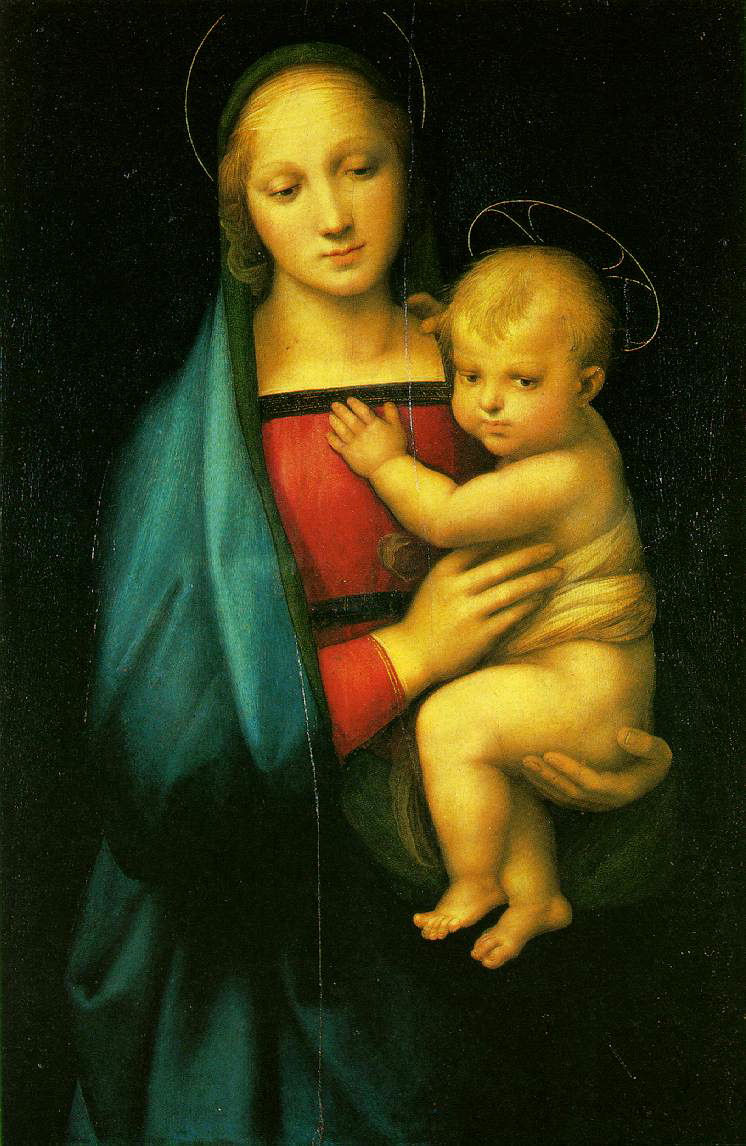
RENOIR
Pierre-Auguste Renoir was among the impressionists who sought to let a diffused light shine through their work. His dedication to his ideal is confirmed by his prolific output of about 6000 paintings. He was an active artist for 60 years. When his hands became arthritic in his old age, he had trouble holding on to his brushes. Consequently, he taped the brushes to his hands so he could continue his Creative Karma Yoga work of letting the divine light shine in his depictions of beauty and unity. His painting "Jeunes Filles Au Piano Vers" is shown below:

VAN GOGH
Before Vincent Van Gogh became a painter, he sought to dedicate his life to God by being a preacher. He failed in that vocation and likewise failed to find peace of mind in his chosen career as an artist. Nevertheless, he is perhaps the best example of Creative Karma Yoga because he single-mindedly dedicated his life to passionately expressing the divine influence speaking through him. In spite of the darkness he found within his own unstable mind, he could see the extraordinary beauty and unity all around him in the world. His paintings let us see the transcendent light shining within the world as he saw it. Also, in many of his paintings, he illustrates the beauty and dignity of ordinary actions that can be seen in everyday work activities. The two paintings of Van Gogh shown below are not his most notable work, but they are presented here because they show the transcendent worthiness of mundane work, which is the foundation of all the dedicated action of Karma Yoga.
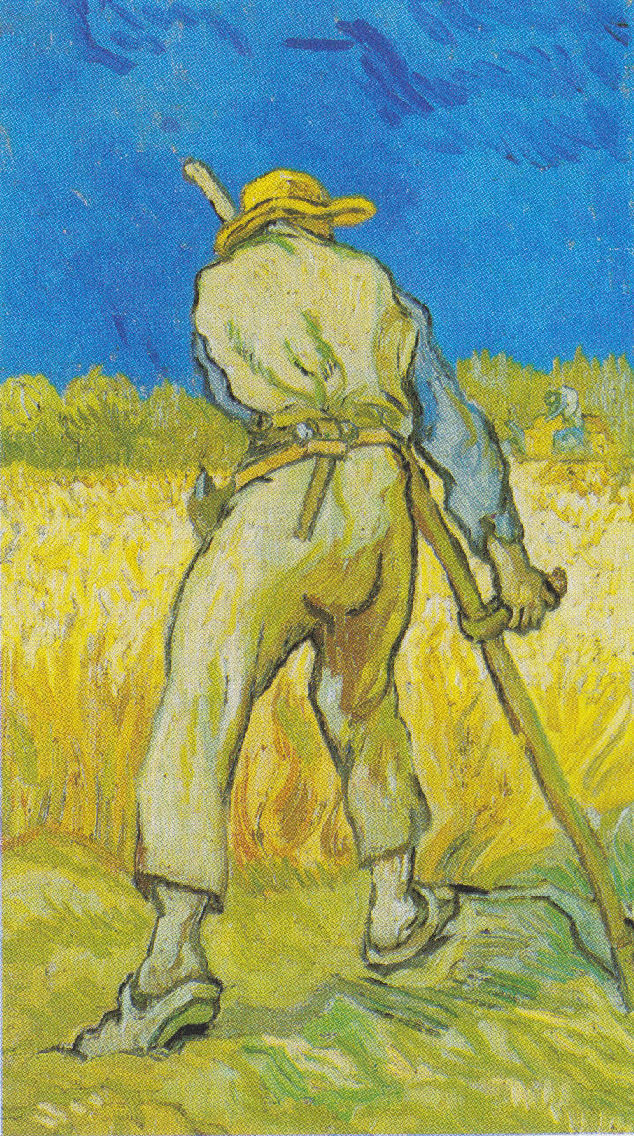
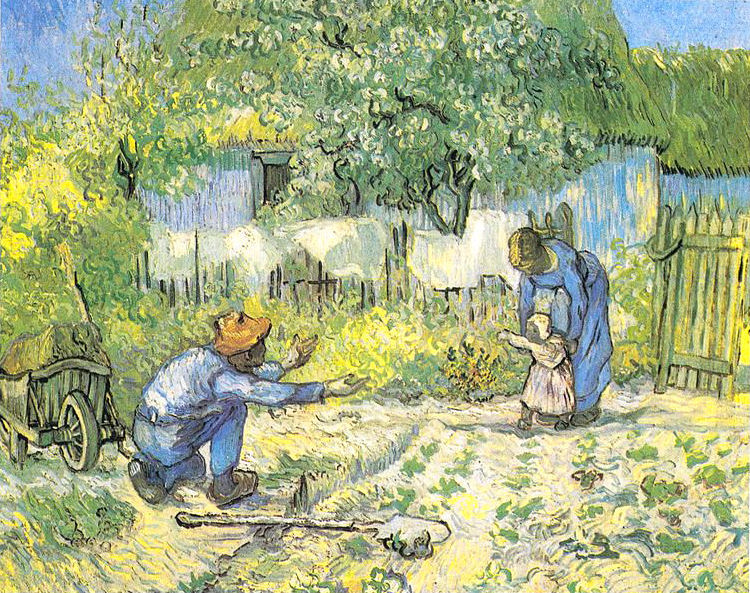
HUMAN LOVE KARMA YOGA
Van Gogh’s painting immediately above
is an example of his Creative Karma Yoga, but it also illustrates another kind
of Karma Yoga. This painting depicts a man interrupting his work to open his
arms inviting his daughter to run to him. This might be an example of Christian
Karma Yoga, but the man could possibly be agnostic or even an atheist. In any
event, it is obvious the man loved his family, and his work in the world was
dedicated to those he loved. This kind of work dedicated to human love is not
traditional Karma Yoga dedicated to God. However, it can be called “Human Love
Karma Yoga,” which is indirectly dedicated to God. After all, Jesus said that
what you do for others—helping the poor, the sick, the imprisoned—is done to
Him. God doesn’t “need” your love, but God certainly wants you to love your
brothers and sisters. Human Love Karma Yoga is actually a secular synthesis of
Karma Yoga and Bhakti Yoga, and these two kinds of traditional yoga go hand in
hand.
Actually Human Love Karma Yoga may be the most common form
of Karma Yoga. Many seekers have not yet realized their spiritual roots and
live a purely humanistic life, but at the same time live their lives as an
expression of human service motivated by human love. Human Love Karma Yoga is
practiced by countless fathers and mothers who devote their lives and work to
their families, whether they also devote themselves to God or not. It is true
that work devoted directly to God is a higher calling that helps set aside the
ego of the worker. However, work devoted only to human love is also extremely
valuable in itself. Besides love of one’s family, there are certainly numerous
other examples of selfless service devoted to our brothers and sisters.
Perhaps the best single example of Human Love Karma Yoga
can ironically be found in war. This website certainly does not celebrate any
form of killing, but human love can be expressed even on the battlefield. The
Marine serviceman Dakota Meyer who received the Congressional Medal of Honor
repeatedly risked his life after he had already been wounded in the arm. He
obviously believed in the Marine motto “no soldier left behind.” When he was
asked in a “60 Minutes” interview if he thought he was going to die, he said,
“I didn’t think I was going to die. I knew I was.” When he was asked why he
went in, Meyer said, “There [were] U.S. troops getting shot at and those are
your brothers.” Later in the interview Meyer said, “You either get them out
alive or you die trying. If you didn’t die trying, you didn’t try hard enough.”
In this case, Meyer did not die, but charging into the face of death is what is
being acknowledged here because of the motivation of human love for others as
an expression of Human Love Karma Yoga.
Christian Bhakti Yoga : Love
Christian Raja Yoga : Meditation
Christian Jnana Yoga : Understanding
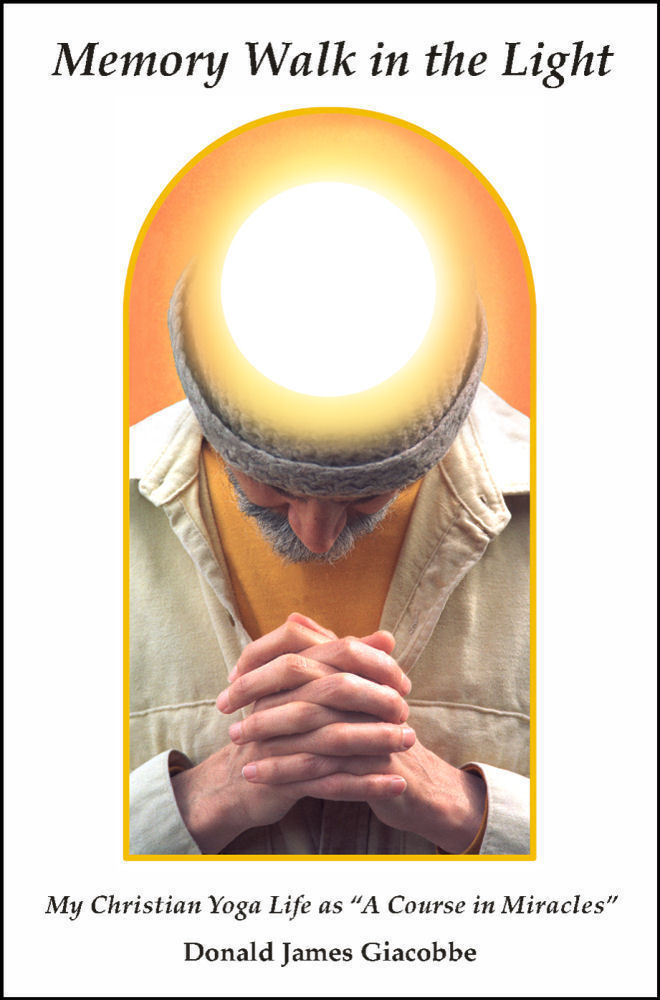
My life is an example of following in the
footsteps of Jesus, while practicing yoga disciplines and applying the
principles of A
Course in Miracles. I am a “monk in the world,” not a
father
with children. Yet, as every father, I would like to leave behind an
inheritance. This autobiography is my inheritance, but it is simply a
reminder
of our Father’s inheritance—His
gift of Himself—to
all of His children. The
only gold in this inheritance is the message of love and forgiveness
that God
wants me to hear, to live, and to share with you. I hope that you are
entertained by my life story of blending the East and West. However,
providing
entertainment is not my goal. My purpose is to encourage you to
increasingly awaken
to the spiritual dimension of your own life. Consequently, this book
includes
how-to appendices on Christian meditation, exercise, and yoga postures,
which
can be practiced by anyone to grow spiritually. The goal is to let your
spiritual practice become a way of life firmly centered in Christ. With
this
goal your spiritual practice starts out as an effort, becomes a
necessity, and
eventually becomes a delight, bringing many blessings.
Click for this autobiography at Amazon.com
Click for "Contact Us"© 2011 Miracle Yoga Services. All rights reserved.
